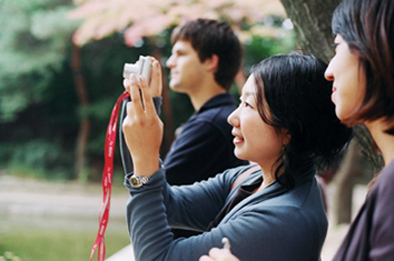
Another new semester has approached and class registration has begun. Students are gathered in front of their personal computers, preparing themselves to click the classes they want to take. After a few seconds, all the foreign language classes such as Chinese, Japanese, French of all levels are closed?full of students wishing to take these class. Likewise, many students nowadays are eager to learn more about foreign languages and cultures, instead of learning of their own culture.
However, there are also classes available on campus to students who are interested in learning more about the past and present of Korean culture. Students who have taken such classes in the past recount their experience, sharing how much they learned and earned from these classes, and recommend them to other Ewha students. Among these classes that cover Korean culture, the Ewha Voice focused on three classes titled Understanding World Heritages inKorea, Korean Life and Culture, and Korean Tradition and Folk Culture, which have gained positive appraisal from students who attended the classes as a means to come to know, experience, and savor Korean culture on campus.
Understanding World Heritages in
Understanding World Heritages in
Students in the class learn about a world heritage located in
With this grand purpose in mind, some students hesitate taking this class because it includes field trips to different cultural spots such as Jongmyo Shrine,
Indeed, the chance to see and feel Korean history and culture through field trips offer students to learn more than they can by just pouring over textbooks. “Among all the places that we have been, I liked
Korean Tradition and Folk Culture
Korean Tradition and Folk Culture is a class designed to discover
Park Gu-bee (Korean Literature, 4) shares her experience of attending this class. “Professor’s interesting lecture, and the class materials such as videos and photos provided students with the opportunity to take a glimpse of Korean culture and people’s lives from a very different perspective. Generally, we are used to the history written by the elites, but through this class, students were able to truly learn of the lives of ordinary Koreans.” Park says that she thinks she has learned “true history” through this class. “I learned countless facts about Korean traditional culture, and found hidden meanings and history behind remnants of Korean culture which we take for granted everyday.”
Korean Life and Culture
Korean Life and Culture looks at the daily lives and arts of the past to classify what can be valued as “true” Korean. The objective of this class is to introduce the philosophical and ideological roots of Korean culture and the Korean way of life. In the past semesters, the class included a time to depict Korean culture and students were given time to make their own images of
Choe Mun-jung (Korean Literature, 4) says this class has special significance for her since it was the first class she took as a Korean Studies major. “I took this class because I wanted to obtain a solid ideological background on Korean culture. Because I have lived abroad for many years, establishing this background was very important,” said Choe. According to Choe, although most people know how Koreans act and think, few understand 'why' Koreans act and think the way they do.
“A wide range of topics are covered through class discussions. At the end of the semester, students choose an aspect of Korean culture that she feels should be publicized and makes a presentation on why and how this should be done,” added Choe.

